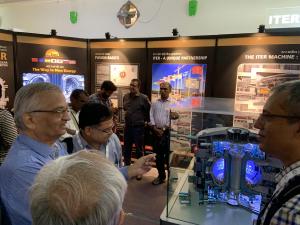India showcases megascience
From micro to macro—specifically, from the India-based Neutrino Observatory (INO) that will study neutrino mass ordering events lasting 10-43 seconds, to the Laser Interferometer Gravitational-Wave Observatory (LIGO), which has detected gravitational waves through the study of black holes and stars in merging events lasting a few billion years—seven of the world's mega-science projects came together last week for the launch of a major exhibition in Mumbai.
Appropriately titled "Vagyan Samagam," from the Hindi words for "science and confluence," the exhibition will move from Mumbai to Bangalaru to Kolkata to Delhi over an 11-month period, raising awareness of ITER and other mega-science projects in which India plays a prominent role.
The ITER project was featured at a special session on Thursday 9 May. Attending dignitaries, audience members, and journalists alike remarked on the physical progress of the project, and the way in which ITER spans both fundamental research and the pragmatic objective of abundant energy.



